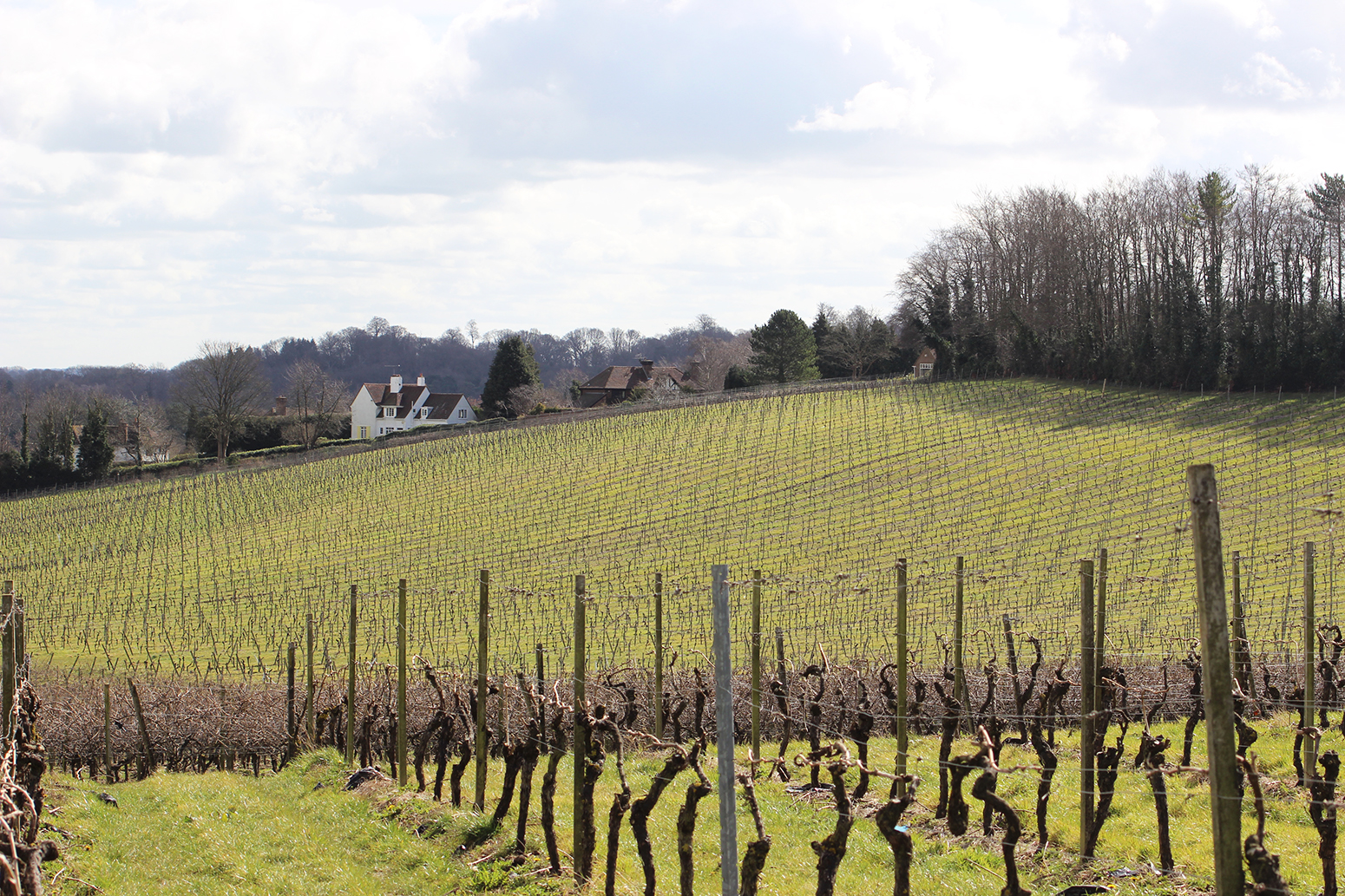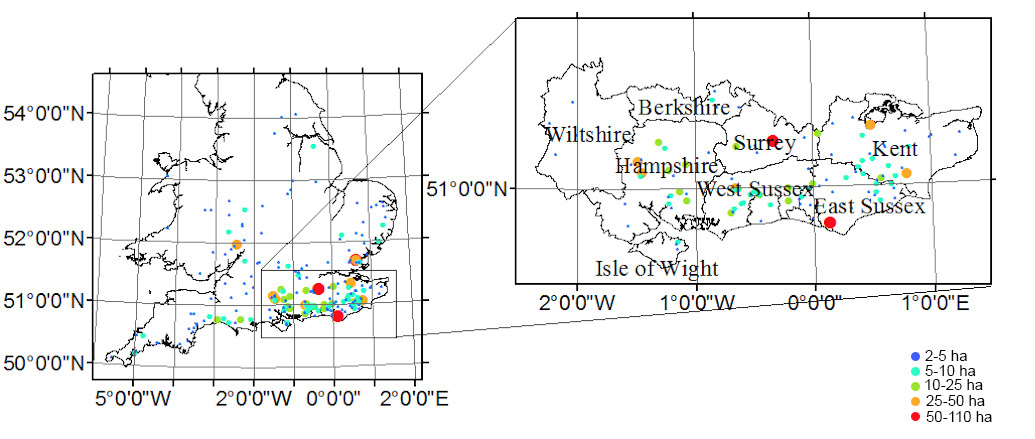
Explainer: Is climate change good news for the UK wine industry?
Roz Pidcock
04.01.16Roz Pidcock
01.04.2016 | 3:06pmNot so long ago, the prospect of a world-class English wine industry was a pipe dream. A mere glint in the eye of a geology professor, who noticed how the chalky soils of southern England resembled those of the Champagne region in France.
Thirty years on and the UK wine industry is blooming. Where premier champagne houses once turned their noses up at an English vintage, our sparkling whites are now celebrated by wine buffs the world over.
The UK industry attributes at least some of its success to climate change, says Alistair Nesbitt, one of the UK’s leading researchers on wine-production. From Riesling to Chardonnay, warmer weather has seen yields flourish and wine quality skyrocket.
But there’s little room for complacency. The biggest risks to successful grape growing haven’t gone away and may even by amplified as temperatures climb higher, says Nesbitt.
According to his research, two thirds of UK vineyard owners view climate change as a threat to their livelihoods, not as a benefit. The new study is published today in the Australian Journal of Grape and Wine Research.
A success story
Between 2004 and 2013, the amount of land in the UK dedicated to growing wine – a practice known as viticulture – grew by 148%. The UK now has in the region of 450 vineyards and more than 1880 hectares is used to grow wine grapes.

Total area under vine in the UK, area in production and total number of vineyards (1989–2013). Source: Nesbitt et al., (2016).
Wine-growing is not new to the UK – evidence points to vineyards in Medieval and Roman times. But the industry has come into its own recently, says Nesbitt. He tells Carbon Brief:
Southern England is home to most of the UK’s vineyards; Sussex, Kent, Surrey, Berkshire, Hampshire, Wiltshire and the Isle of Wight. The largest single vineyard, Denbies Wine Estate, nestled in the North Downs near Dorking, covers an area the size of 75 football pitches.
“Champagne trio”
In the last decade, vineyard owners have increasingly favoured sparkling over still wine, says Nesbitt. And it’s this for which the UK is most celebrated.
Since about 2004, the industry has seen a shift away from the classic Germanic grapes on which it built its foundations, such as Müller-Thurgau and Reichensteiner, says Nesbitt. Instead, it has moved towards the more prestigious chardonnay and pinot noir varieties used to make sparkling wine.
It’s largely down to the success of these grapes that the industry took off in the UK, says Jane Awty, who runs the Oatley Vineyard in Somerset with her husband Iain. She tells Carbon Brief:
Back in the late 1980s, Nyetimber pioneered English sparkling wine, which the vineyard’s winemaker Brad Greatrix says has now become a “serious contender to Champagne”. He tells Carbon Brief:
With supermarkets from Waitrose to Lidl now stocking English sparkling wine, consumer demand for a good, locally-sourced wine is high, says Nesbitt. As for quality, the proof is in the quaffing, he tells Carbon Brief:
Indeed, so impressed was the French champagne house, Taittinger, with the UK’s growing conditions that it bought up 69 hectares in Kent recently.
To what does the UK owe its success?
The idea that climate change could make high latitude regions, such as the UK, more suitable for wine-making has been around for some time.
With UK summer temperatures rising by about 0.28C per decade since the 1960s – faster than the global average – it is often assumed this is what’s happening. But the link hasn’t been examined until now, says Nesbitt.
He and his team analysed monthly temperature and rainfall data for southern England between 1954-2013. Together with information about grape yields, they were able to pinpoint the conditions that, statistically-speaking, tend to result in good harvests.
The study also asked UK wine-growers for their views on climate change, specifically whether they thought it had contributed to the growth of their industry.
Good crop, bad crop
Wine grapes need specific conditions to flourish. Historically, good years are characterised by a warm spring with little or no frost, followed by a long summer and a dry autumn, says Nesbitt.
The study shows that in the last 10-15 years, average temperatures during the grape growing season (April to October) have tended to fall above 13C. This is the minimum temperature that “cool climate” wine grapes need to thrive, Nesbitt tells Carbon Brief.
Rising temperatures are, at least in part, responsible for the UK joining the global wine-making elite, says Christopher White, chief executive of Denbies. He tells Carbon Brief:
But while rising temperatures may have boosted the UK wine industry’s potential, the occurrence of frost and rainfall at critical times in the growing season haven’t gone away – and it’s these that ultimately decide the quality of the harvest, says Nesbitt.
High stakes
Counterintuitively, climate change may be increasing the risk of a disappointing year, says Nesbitt. As spring temperatures rise, grape vines are coming into life earlier in the year. For most vineyards, this means the whole season is shifting forwards. Awty tells Carbon Brief:

Annual average growing season temperature (Apr-Oct) in south-east and south-central UK (red) and the trend over the 1954-2013 period (yellow). The same for rainfall is shown in blue. Source: Nesbitt et al., (2016).
While a spring boost after a long winter might sound positive, established shoots are more vulnerable to frost than buds in the earlier stages of growth. Awty tells Carbon Brief:
Historically, frost in April or May has led to some of the lowest yielding years on record, says Nesbitt. June is also a critical month in the UK wine-growing calendar, he tells Carbon Brief:
He found that the amount of rain that falls in June is the most critical factor in the success of a wine crop. This means weather conditions can still conspire to outweigh any benefit that might come from a trend towards warmer average temperatures. Greatrix, Nyetimber’s winemaker, tells Carbon Brief:
“The variable weather in 2012 – which included the wettest June and coldest summer since records began – led us to decide not to harvest any of our grapes that year, as the quality was not up to our standard.”
Dr Jonathan Mosedale, an expert in UK wine at the University of Exeter who wasn’t involved in the new study, echoes this point. He tells Carbon Brief:
A tricky issue for the industry to navigate now, however, is that the more prestigious champagne grapes are the most susceptible of all. Mosedale says:
In its pursuit of prestige, will the UK wine industry become a victim of its own success?
Not necessarily, says Nesbitt. But it falls to individual producers to identify the risks within their vineyard and to balance that against growing demand, he adds.

Vineyards at Denbies wine estate, near Dorking, England, 30/03/2016. Credit: Rosamund Peare/Carbon Brief.
Survey attitudes
The survey of UK wine-producers reveals a community that is far from complacent about the position in which it now finds itself.
Of the 42 respondents to the survey, 66% said they thought climate change had, or maybe had, contributed to the growth of UK industry. Another 23% said it hadn’t, or were doubtful that it had, while 11% said they did not know.
Perhaps more revealingly, says Mosedale, is that nearly two thirds of respondents (64%) perceived climate change as a general threat to wine production in the UK. Reasons cited for this were greater year-to-year variability, extreme weather and a greater potential for pests and disease from warmer, wetter weather during the harvest season.
Of the survey respondents, just 7% said they thought higher yields and a greater choice of grapes meant climate change presented more of an opportunity than a threat. A further 29% said it was probably a bit of both.
Wine producers are also mindful that, while climate change may have given the UK industry a boost in the last decade or so, the same has not been true in other parts of the world. Denbies’ Christopher White tells Carbon Brief.
No complacency
The mood of today’s study is one of cautious optimism. Producers can keep enjoying their success, says Nesbitt, but should be prepared to buffer themselves against the continuing threat of weather shocks.
For anyone looking to set up a vineyard or expand an existing one, he has some advice, telling Carbon Brief:
Producers are also quick to credit the industry’s success to growing expertise, better technical know-how and good old fashioned trial and error. Nyetimber’s Brad Greatrix tells Carbon Brief:
Main image: Vine in Denbies wine estate, near Dorking, England.
Nesbitt, A. et al., (2016) Impact of recent climate change and weather variability on the viability of UK viticulture – combining weather and climate records with producers’ perspectives. The Australian Journal of Grape and Wine Research. DOI:10.1111/aigw.12215.


